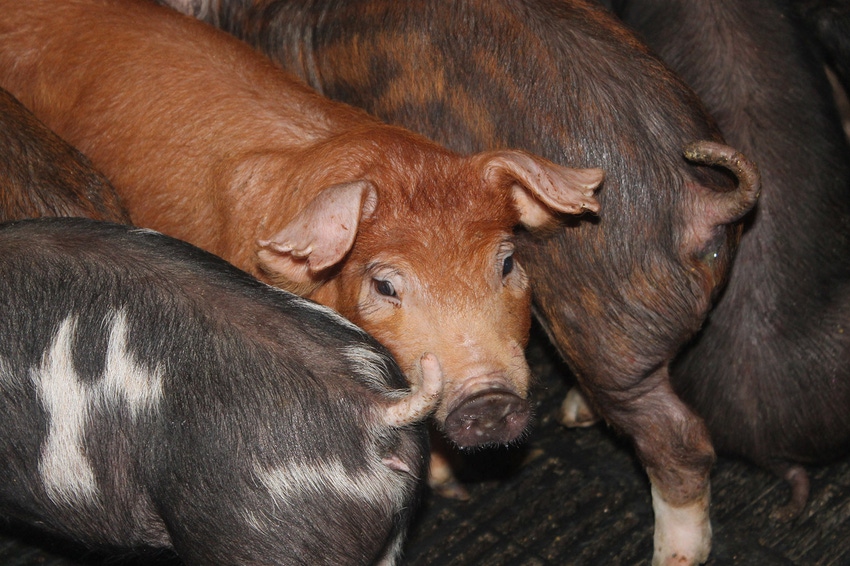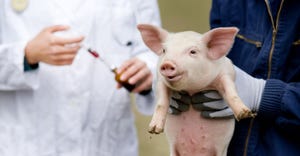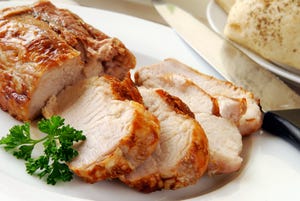SID lysine impact on growth performance, economic return
Objective to determine optimal standardized ileal digestible lysine requirement for Duroc-based finishing pigs reared in a commercial environment.
May 12, 2022

Establishing dietary lysine requirement estimates is crucial for maximizing lean growth and reducing feed cost in finishing pigs. There are several factors that impact dietary lysine requirements including: genetics, environmental conditions, sex and pig body weight.
Continuous improvements in genetics of modern pigs have resulted in increased growth performance and protein accretion. These may potentially increase amino acid requirement estimates. While genetic suppliers provide amino acid requirement estimates for the various weight ranges of their specific lines, validating these levels is needed within production systems to achieve optimum performance and economic return.
Choosing a terminal sire to use in a swine breeding program is important because it influences traits including growth rate, carcass characteristics and pork quality, and alters nutrient requirements. Recently, the U.S. swine industry has placed increased emphasis on pork quality resulting in the use of more Duroc-based terminal sires. Durocs are characterized by their excellent growth rate and intramuscular fat content. Furthermore, Durocs have a higher feed intake compared to large white pigs. As a result, nutritional requirements need to be re-evaluated as genetic progress is made over time. Therefore, the objective of these experiments was to determine the optimal standardized ileal digestible lysine requirement for growth performance and economic return of Duroc-based finishing pigs reared in a commercial environment.
In experiment 1, a total of 2,124 barrows and gilts (PIC 1050 ´ DNA 600; initially 107.9 ± 1.31 lb) were used in a 32-day study to determine the optimal level of dietary standardized ileal digestibility Lys for 108 to 178 lb pigs in a commercial setting. Pigs were randomly allotted to one of five dietary treatments with 24 to 27 pigs per pen and 16 replications pen treatment. A similar number of barrows and gilts were placed in each pen.
Diets were fed over three phases (108 to 129, 129 to 156, and 156 to 178 lb, respectively). Dietary treatments were corn-soybean meal-based and contained 10% (phase 1 and 2) or 5% (phase 3) distiller's dried grains with solubles. Diets were formulated to 85, 95, 103, 110 or 120% of the 2016 PIC SID Lys gilt recommendations as follows: phase 1 SID Lys levels of 0.90, 1.01, 1.09, 1.17 and 1.27%; phase 2 levels of 0.79, 0.87, 0.94, 1.03 and 1.10%; and phase 3 levels of 0.71, 0.78, 0.85, 0.92 and 0.99%, respectively.
Overall (d 0 to 32), increasing SID Lys increased (linear, P < 0.001) ADG, final body weight, Lys intake/d and Lys intake/kg of gain with an improvement in feed to gain (quadratic, P = 0.047). Additionally, feed cost per pig, feed cost per lb of gain, total revenue per pig and income over feed cost increased (linear, P ≤ 0.002) as SID Lys increased. Projecting IOFC, broken line linear and quadratic polynomial models estimated the maximum IOFC at 105.8% and 113.7% SID Lys, respectively. In summary, while growth performance increased linearly up to 120% of the 2016 PIC recommended Lys requirement, the optimal IOFC was 106% to 114%.
In experiment 2, a total of 2,099 barrows and gilts (PIC 1050 ´ DNA 600; initially 198.6 ± 3.72 lb) were used in a 57-day study to determine the optimal dietary SID Lys level for approximately 200 to 300 lb pigs. Pigs were randomly allotted to one of four dietary treatments with 24 to 27 pigs per pen and 20 replications per treatment. A similar number of barrows and gilts were placed in each pen.
Diets were fed over two phases (199 to 233 and 233 to 299 lb, respectively). Dietary treatments were corn-soybean meal-based. Diets were formulated to 85, 93, 100 or 110% of the 2016 PIC SID Lys gilt recommendations with phase 1 SID Lys levels of 0.65, 0.71, 0.77, 0.84%, and phase 2 levels of 0.60, 0.66, 0.71, 0.78%, respectively.
Overall (d 0 to 57), increasing SID Lys increased (linear, P < 0.05) overall market weight, F/G, hot carcass weight, Lys intake/d and Lys intake/kg of gain with an increase in average daily gain (quadratic, P = 0.020). For economics (d 0 to 57), feed cost per pound of gain increased (linear, P < 0.05) with increased SID Lys. Revenue per pig placed and IOFC increased (quadratic, P < 0.10) as the amount of SID Lys increased, and marginally significant evidence of a quadratic response for feed cost per pig placed (P = 0.073).
Projecting IOFC for phase 1, the quadratic polynomial and broken-line linear models estimated the requirement at 110.9% and 96.9%, respectively, to achieve maximum IOFC. For phase 2, the QP estimated the requirement at 96.6% SID Lys to maximize IOFC. In summary, the SID Lys requirement was 97% to 111% of 2016 PIC recommended Lys requirement for phase 1 and 97% for phase 2 to maximize IOFC.
In conclusion, while growth performance increased linearly up to 120% of the 2016 PIC recommended Lys requirement, the optimal IOFC was 106% to 114% for 108 to 178 lb pigs. For 200 to 300 lb pigs, the SID Lys requirement was 97% of 2016 PIC recommended Lys requirement to maximize IOFC.
The full data is available at KSU Swine page with the 2021 K-State Swine Industry Day Reports.
Source: Larissa L. Becker, Joel M. DeRouchey, Mike D. Tokach, Jason C. Woodworth, Robert D. Goodband, Emily E. Scholtz, Jon A. De Jong, Fangzhou Wu, Kiah M. Berg, Joe P. Ward, Casey R. Neill and Jordan T. Gebhardt, who are solely responsible for the information provided, and wholly own the information. Informa Business Media and all its subsidiaries are not responsible for any of the content contained in this information asset.
You May Also Like



